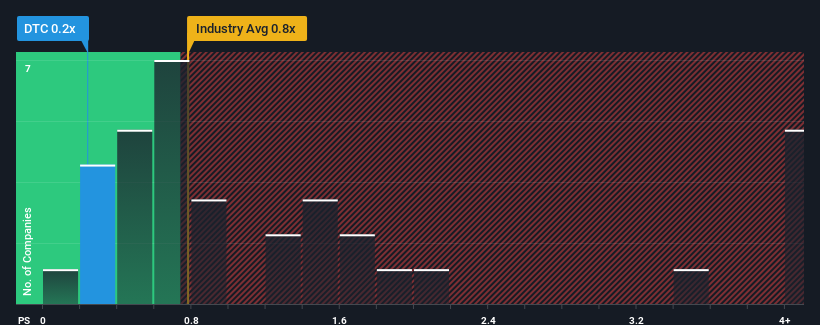- United States
- /
- Leisure
- /
- OTCPK:DTCB
Market Cool On Solo Brands, Inc.'s (NYSE:DTC) Revenues Pushing Shares 25% Lower

To the annoyance of some shareholders, Solo Brands, Inc. (NYSE:DTC) shares are down a considerable 25% in the last month, which continues a horrid run for the company. For any long-term shareholders, the last month ends a year to forget by locking in a 69% share price decline.
Following the heavy fall in price, given about half the companies operating in the United States' Leisure industry have price-to-sales ratios (or "P/S") above 0.8x, you may consider Solo Brands as an attractive investment with its 0.2x P/S ratio. However, the P/S might be low for a reason and it requires further investigation to determine if it's justified.
View our latest analysis for Solo Brands

How Solo Brands Has Been Performing
The recently shrinking revenue for Solo Brands has been in line with the industry. It might be that many expect the company's revenue performance to degrade further, which has repressed the P/S. You'd much rather the company continue improving its revenue if you still believe in the business. In saying that, existing shareholders may feel hopeful about the share price if the company's revenue continues tracking the industry.
If you'd like to see what analysts are forecasting going forward, you should check out our free report on Solo Brands.Is There Any Revenue Growth Forecasted For Solo Brands?
The only time you'd be truly comfortable seeing a P/S as low as Solo Brands' is when the company's growth is on track to lag the industry.
In reviewing the last year of financials, we were disheartened to see the company's revenues fell to the tune of 4.4%. However, a few very strong years before that means that it was still able to grow revenue by an impressive 271% in total over the last three years. Although it's been a bumpy ride, it's still fair to say the revenue growth recently has been more than adequate for the company.
Turning to the outlook, the next three years should generate growth of 4.3% each year as estimated by the eight analysts watching the company. That's shaping up to be materially higher than the 1.7% per year growth forecast for the broader industry.
With this information, we find it odd that Solo Brands is trading at a P/S lower than the industry. It looks like most investors are not convinced at all that the company can achieve future growth expectations.
What Does Solo Brands' P/S Mean For Investors?
The southerly movements of Solo Brands' shares means its P/S is now sitting at a pretty low level. We'd say the price-to-sales ratio's power isn't primarily as a valuation instrument but rather to gauge current investor sentiment and future expectations.
To us, it seems Solo Brands currently trades on a significantly depressed P/S given its forecasted revenue growth is higher than the rest of its industry. When we see strong growth forecasts like this, we can only assume potential risks are what might be placing significant pressure on the P/S ratio. At least price risks look to be very low, but investors seem to think future revenues could see a lot of volatility.
It's always necessary to consider the ever-present spectre of investment risk. We've identified 1 warning sign with Solo Brands, and understanding should be part of your investment process.
If strong companies turning a profit tickle your fancy, then you'll want to check out this free list of interesting companies that trade on a low P/E (but have proven they can grow earnings).
New: Manage All Your Stock Portfolios in One Place
We've created the ultimate portfolio companion for stock investors, and it's free.
• Connect an unlimited number of Portfolios and see your total in one currency
• Be alerted to new Warning Signs or Risks via email or mobile
• Track the Fair Value of your stocks
Have feedback on this article? Concerned about the content? Get in touch with us directly. Alternatively, email editorial-team (at) simplywallst.com.
This article by Simply Wall St is general in nature. We provide commentary based on historical data and analyst forecasts only using an unbiased methodology and our articles are not intended to be financial advice. It does not constitute a recommendation to buy or sell any stock, and does not take account of your objectives, or your financial situation. We aim to bring you long-term focused analysis driven by fundamental data. Note that our analysis may not factor in the latest price-sensitive company announcements or qualitative material. Simply Wall St has no position in any stocks mentioned.
About OTCPK:DTCB
Solo Brands
Operates a direct-to-consumer platform that offers outdoor and lifestyle branded products in the United States.
Mediocre balance sheet low.
Market Insights
Community Narratives




